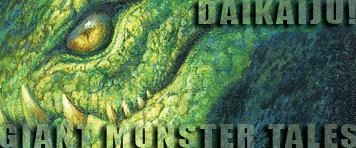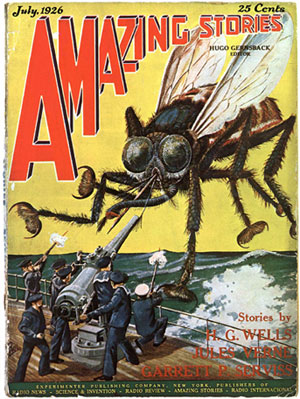

| Anthology
Submission Guidelines Confirmed
Title:
That's it in essence. However, we have included an extensive elaboration of what we are looking for at the end of these Guidelines. Please read this if you are at all interested in submitting -- otherwise you may be wasting your time. |


| Note: Under no circumstances can we include stories which feature Godzilla, Gamera, Mothra, Anguilas, King Ghidorah, Gorgo, King Kong or any other copyrighted character (including those named in the film posters used to decorate this page). Your characters, whether monstrous, human or alien, must be original, though allusive reference to famous daikaiju may be acceptable depending upon the context.
We will consider stories of any length, though it will be very difficult for us to accommodate anything over 12,000 words, merely from space considerations. Such stories will need to be stunningly original and irresistibly brilliant to get in.
Stories will be accepted from writers worldwide. However, they should be in English. |
Payment: At least AUS$ 30 per story, plus one contributor's copy, for first publication rights, with an option on subsequent editions. This may vary upward as we approach the publication date, depending on our financial situation. The initial print-run will be small, though this will be governed by circumstances and initial demand.
The
proposed publication date for the anthology is mid 2005. The deadline
for stories is 30 November 2004. We realise that this date is a
long way off, but as it is unlikely that most (any?) prospective
contributors will have appropriate stories in their 'unused' drawer,
we want to give plenty of time for top-quality stories to be developed.
Note on possibility of a comic strip story: While we do not plan to include illustrations or pictures throughout, we will consider including one comic-strip (manga-style) tale, should we be offered one that we like. Such a comic-strip tale should be in black-and-white, with frame sizes clearly viewable on an A5 page. Please contact us by email before submitting. |


Submission: If
you prefer to submit in hard copy form, please ensure that the manuscript
is in appropriate (clear, double-spaced, one side of paper only
etc.), and disposable, manuscript form to: Agog!
Press
We don’t mind multiple submissions, but have some mercy on us and don’t send a dozen all at once! |
Guideline summary:
|

| Elaboration Regarding What We're Looking For: We're not talking mere dinosaurs or eagle-sized mosquitoes here; these monsters must be unreasonably huge -- larger than the laws of physics can comfortable accommodate. (You may, of course, be creative in your explanation as to how such creatures are possible within the context of your story. Or you need not explain at all.) The term 'daikaiju' is Japanese in origin, and refers to a tradition of film story that began with the 1954 version of Gojira, better known in the West as 'Godzilla'. Literally, 'daikaiju' translates as 'great (or giant) monster' and is used in relation to films ('eiga') featuring impossibly oversized creatures both pseudo-scientific and mythic. In the classic Japanese giant monster films ('daikaiju eiga'), these creatures trash major cities, engaging in conflict with other monsters or the military -- sometimes acting in mankind's (or rather the Earth's) defense, sometimes set on a course of total genocide, sometimes taking a much more ambiguous role. Japanese giant monsters have included mutated dinosaurs, a bio-engineered flying turtle, huge pterosaurs, an alien squid, a conglomerate smog-monster, a sea-serpent, a moth, a prehistoric dragonfly, metamorphosing freaks of various kinds, cyclopean space starfish, strange chimeras, robots ... even a golem-like statue that is activated in order to defend the helpless. In some, such as the Ultraman series, there is a superhero component -- humanoid aliens with the ability to grow to gigantic size in order to fight giant monsters sent to the Earth by megalomaniacal conquerors. Unlike the typical US giant-monster-on-a-rampage, these Japanese daikaiju generally carry with them a greater sense of sentience or purpose -- they are more than mere animals, even if that 'more' is merely the quality of being an unstoppable force of nature or some other metaphorical resonance. Generally, they have personality, though not necessarily of an anthropomorphic kind. Their presence often comments on life and reality. Metaphorical qualities relating back to the culture that spawned them is a significant part of their construction -- the first Godzilla, for example, was an anti-nuclear allegory that made passionate if indirect reference to Hiroshima. At any rate, the Japanese films are generally much more resonant (and often more playful) than the typical US 'giant insect' flicks of the 1950s and beyond. What is intended for this anthology is that contributors will create original giant monsters and original story lines featuring them, and develop their own viable and intriguing mythology in the process. These stories may be SF, fantasy or horror in approach, set in the present, the future or the past (alternative history), serious, humorous, satirical, romantic or adventurous in tone, feature one or many monsters, be written from any point-of-view, and be as 'complete' or 'episodic' as the author sees fit, provided that they offer a unified, satisfactory experience to the reader. Contributors should consider where the profound and seemingly limitless appeal of the most successful giant monster films and stories lies; let your imagination enter that playground and experiment with its tropes. Originality, not necessarily in the form of the monster, but in concept, plot line or approach, will be the key to success in regards to this anthology. The editors do not anticipate that the writer's task will be easy, as they are looking for intelligent, innovative works in this fascinating yet often under-realised (and often cheesy) genre, and are hoping to find stories based on truly intriguing concepts and conveying a profound sense of awe. We are keen to see stories that take a new approach to the daikaiju genre or use daikaiju to throw new light on life and reality; we'd love to receive some good 'postmodern' monster stories (think Waldrop and Chabon). While one or two stories that offer an original approach to the straightforward 'city-destroying monster' trope will be included if we are sent something appropriately compelling, we are really looking for a more innovative response to the project brief. In essence, of course, what we want is good writing and good ideas, so no matter what approach you take, if you think it's good, send it in. |
The anthology is to be published by Agog! Press.
You can email the editors at <daikaiju@roberthood.net>
but read this first!